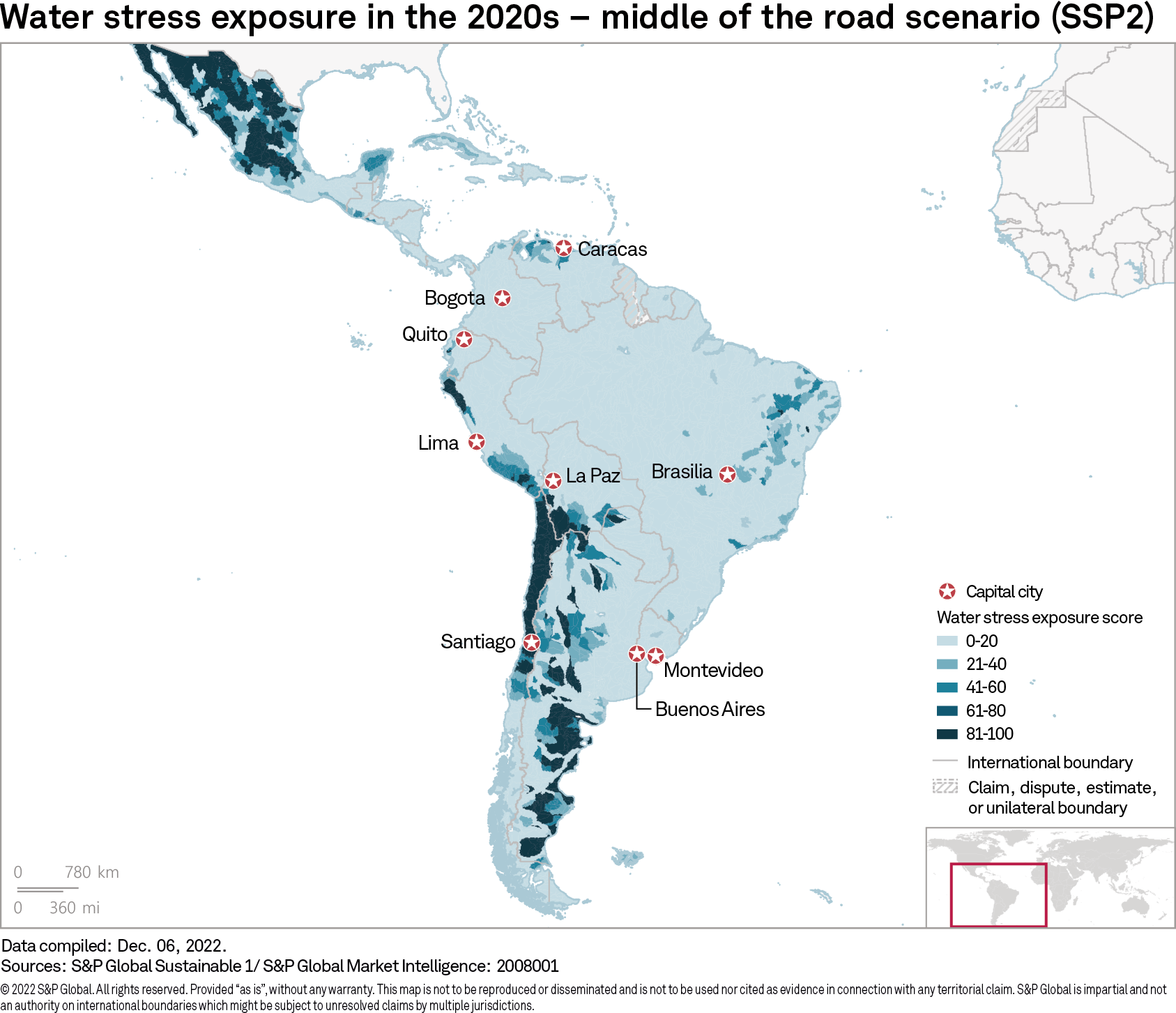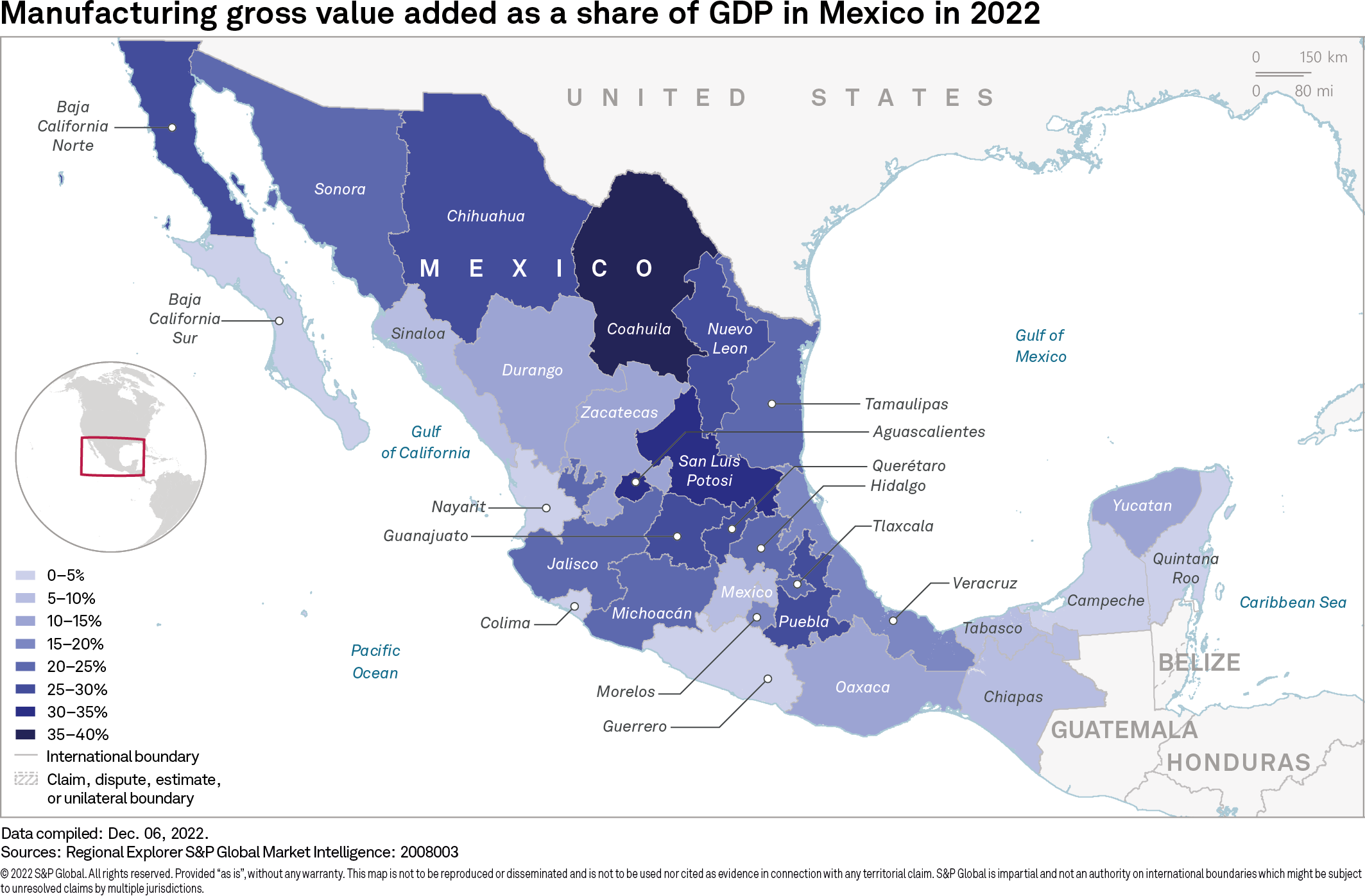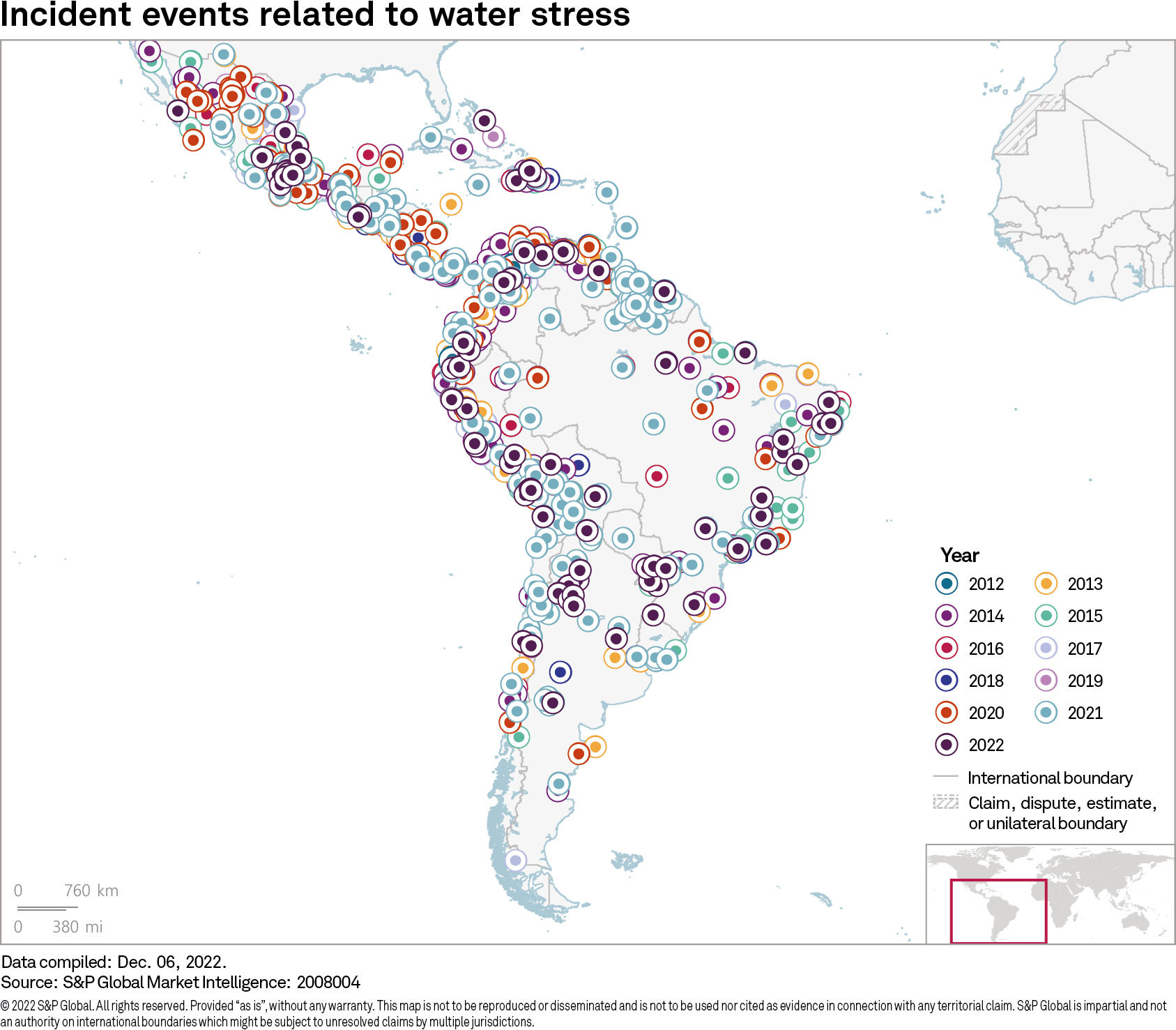- Speak to a Specialist
- Who We Are
- Who We Serve
- Solutions
- Research & Insights
- Events
Access to water is likely to become increasingly strategic and disruptive in Latin America over the coming decade. Climate scenario projections for the coming decades forecast that water stress and drought frequency will increase in many parts of Latin America, particularly in southern Argentina, northern Mexico and the Antofagasta region in northern Chile. Water scarcity is likely to be an ongoing constraint to the region’s contribution to meeting global energy transition targets, affecting lithium extraction and green hydrogen.
Published: November 21, 2022
Access to water is likely to become increasingly strategic and disruptive in Latin America over the coming decade. Climate scenario projections for the coming decades by S&P Global Sustainable1 forecast that water stress and drought frequency will increase in many parts of Latin America, particularly in northern Chile, southern Argentina and the Antofagasta region in northern Chile.
Water shortages and the resulting popular protests will increase the risk of government scrutiny into terms of water concessions, increased regulation and higher tariffs.
Water stress and drought will also pose risks particularly to electricity generation (hydropower comprises 45% of Latin America’s electricity matrix), manufacturing and agriculture.
Delays to road cargo transportation are likely because of water disputes between local communities and governments, with fluvial supply chains also affected by delays and higher costs because of lower levels of water in rivers and canals.
Water scarcity is likely to be an ongoing constraint to the region’s contribution to meeting global energy transition targets, affecting lithium extraction and green hydrogen.
Authors: Veronica Retamales Burford, Senior Research Analyst, S&P Global Market Intelligence | Marie Lechler, Data Analytics Director, S&P Global Market Intelligence | Rick Lord, Head of Innovation Methodology, S&P Global Sustainable1
Contributors: Carlos Caicedo, Research and Analysis Associate Director, S&P Global Market Intelligence | Johanna Marris, Senior Research Analyst, S&P Global Market Intelligence | Ailsa Rosales, Senior Research Analyst, S&P Global Market Intelligence | Carla Selman, Principal Research Analyst, S&P Global Market Intelligence | Jose Enrique Sevilla-Macip, Senior Research Analyst, S&P Global Market Intelligence
Water scarcity in Latin America is likely to intensify supply chain and operational disruptions, regulatory risks and economics losses for businesses over the next decade. This special report reviews a selection of countries and sectors to assess the impact of water issues and extreme weather events in Latin America during the coming five years.
Extreme weather events such as water stress, floods and droughts have led to additional operational challenges in Latin America in recent years. Restricted electricity generation, supply chain disruption, damage to production sites and agricultural losses will continue generating detrimental economic and political effects. These include reducing income levels, increased migration, and rising contract alteration and protest risks. S&P Global Sustainable1 projects increased water-related stress across many parts of Latin America during the current decade. Simulations based on a middle-of-the-road climate scenario show that water stress in Latin America will be particularly pronounced in southern Argentina, northern Mexico and the Antofagasta region of northern Chile. Water basins in all these regions are estimated to have a water stress exposure score of above 90, out of a maximum of 100, for the current decade. The middle-of-the-road scenario assumes strong mitigation measures and total greenhouse gas emissions that stabilize at current levels until 2050 and then decline in the period to 2100.

Water stress coincides with drought risk in many parts of the continent, according to the same middle-of-the-road scenario. The drought conditions index is expected to be higher than the historic top 10% of index values for more than 10% of the period in northern Mexico, southern and central Argentina, and southern Brazil in the current decade to 2030. By the 2050s, the index is expected to be higher than the historic top 10% of daily readings on more than 15% of the daily measurements across almost all of Latin America and to surpass the levels for more than half a year in the Chile/Bolivia border region, in the Chile/Argentina border region, in southern Argentina and on the Falkland Islands. In this report, we review a selection of countries and sectors to assess the impact of water issues and extreme weather events in Latin America during the coming five years.

Latin America’s vulnerability to extreme weather events poses risks for electricity generation, increasing production costs and the likelihood of shortages. A key example illustrating the region’s vulnerability to extreme weather events is the risk that droughts and floods pose to electricity generation, increasing production costs and the likelihood of shortages in the five-year outlook. Hydropower is the main source of electricity generation in the region and comprises 45% of Latin America’s electricity production. Low water levels due to changing rainfall patterns with prolonged dry periods increase the need for alternative energy sources and are likely to result in significantly higher electricity prices for businesses. Brazil for example, with 65% of its electricity matrix from hydropower, faced reservoir levels in 2021 at their lowest in over 20 years, with a state of emergency imposed in five states. The period of drought in June 2021 was followed by periods of extreme flooding in December 2021, which caused two dams to burst and endangered 10 others. Although such floods in Brazil did not directly affect electricity generation, flooding incidents in the region have previously severely affected dams. More frequent extreme weather events in the region are therefore highly likely to lead to a trend of rising corporate electricity costs in the five-year outlook.
Water shortages are worsening operational disruption, protests, and contract revision risks for companies in the manufacturing sector. Conditions caused by water shortages in Latin America also increase the likelihood of operational disruption and contract revision risks for companies in the manufacturing sector. This has been the case in Mexico, which experienced some of the severest water shortages on record during 2022 because of low rainfall, population growth, and warmer temperatures in its north and northeastern states. The north of Mexico is particularly vulnerable to increased water stress and drought risk while being economically reliant on the manufacturing sector — up to 40% of GDP. Given shortages in Nuevo León state in July, particularly affecting Monterrey, the federal government intervened by initially requesting that industrial and manufacturing firms voluntarily return water to the main system. After failing to achieve an improvement in water supplies, Mexican President Andrés Manuel López Obrador issued a decree on July 29 allowing the government to exercise temporary control over existing water rights to redistribute them for public use as necessary. On Nov. 7, López Obrador stated that he requested preparations for a bill to amend the country’s water legislative framework, focusing on restricting water-use permit allocation in areas facing high levels of water stress. He explicitly singled out the states of Nuevo León, Baja California, Coahuila and Durango as locations where the future bill would restrict the presence of water-intensive industries. Mexico’s water shortages will be exacerbated in the one-year outlook as a result of the U.S. Interior Department’s announcement in August 2022 that Mexico would need to reduce by 7% its water intake from Lake Mead, which feeds the Colorado River Basin, from 2023 because of its low water levels.

Droughts and flooding events worsen the risk of lower crop yields and higher food prices. Higher temperatures and lower-than-average rainfall levels are likely to increase the risk of lower crop yields and consequently higher food prices in the five-year outlook. The weather extremes experienced during the 2021-22 crop season severely affected several major agribusiness-producing countries in Latin America. Argentina, the third-largest global soybean and maize producer, experienced $2.9 billion in total losses within its agribusiness sector. As drought remains an issue in Argentina, an estimated 15% of wheat production will be lost with significant delays to maize planting for the current season. Brazil’s agricultural sector experienced $9 billion in losses in 2021 because of drought. According to the Brazilian Association of the Coffee Industry, drought and recent frosts destroyed the entire plantations of coffee in the state of Minas Gerais, where almost 50% of Brazil’s coffee is produced. Although crop estimates indicate that crop yields are likely to recover during the 2022-23 season in Brazil, weather phenomena, including La Niña, are also likely to affect crops in the Parana River Basin during 2022, affecting Argentina as well, with growing risk of further extreme weather events affecting crops and raising costs for producers, exporters and consumers. As extreme weather events become more accentuated in the five-year outlook, crop yields are likely to become increasingly unreliable, leading to food shortages and lower agricultural revenues.
Sustained periods of droughts will encourage legislative efforts to limit companies’ water use, increasing the regulatory burden for the agriculture sector. Chile currently faces a 13-year megadrought, with agriculture and livestock producers the most affected, particularly in the north and center of the country, with $1 billion estimated losses just in 2020, according to the Ministry of Agriculture. In April, a new water code was introduced in Chile after 11 years of legislative discussions. The agriculture sector, which uses more than 70% of available water, is likely to face stringent application of the new water code. It reinforces the character of water as a public good, prioritizing its use for consumption and sanitation. In Latin America, countries that face similarly acute and prolonged droughts as in Chile, government, legislative and public pressure is likely to be imposed on companies and sectors with high water usage, requiring them to donate or forgo water supplies to increase water availability for domestic use, with agriculture potentially most affected because of its high proportion of water use.
Water disputes are likely to increase disruption to road cargo, damaging supply chains. Disputes over water usage between communities and state governments, such as the recent protests in Mexico’s Tamaulipas state demanding transfer of water from Nuevo León state, are likely to increase disruption to road cargo. Protests in 2020 over the federal Mexican government’s decision to relocate water flows from La Boquilla Dam to comply with international obligations for water transfer led to $700 million in losses following road blockades during more than a one-month period. Further protests and roadblocks due to water concerns disrupting operations are likely, particularly in northern Mexico, where water stress is more acute and through which more than 80% of U.S.-bound exports are transported by land. Our Economics and Country Risk open-source intelligence collection system data is highlighted in the infographics below.

Changes in water levels will affect global supply chains relying on rivers and canals to move cargo. Rising temperatures and changing precipitation patterns are likely to reduce critical water levels in rivers and canals used for transportation by significant numbers of vessels, impacting supply chains at both the local and global levels in the five year-outlook. It is likely to apply in the Panama Canal Basin, where 13,000 vessels crossed in 2021 — 2.4% of global maritime trade. In 2020, the Panama Canal Authority (Autoridad del Canal de Panamá, or ACP) imposed a fee for water usage, after a 20% decline in precipitation levels during 2019 forced the imposition of lower maximum draft requirements for crossing. Disruptions derived from such temporary weight restrictions are likely to become increasingly common, leading to transportation delays and higher costs. Similarly affecting supply chains in South America, the Paraná River Basin is a principal route for the transportation of agribusiness products between Brazil and Argentina and forms part of the fourth-most transited waterway in Brazil. Soybeans and corn make up most of Paraná River cargo. However, during periods of drought, as in 2021, restrictions were applied to cargo on the waterway, given low water levels in the river basin, restricting vessels to 75% of their normal cargo capacity. More severe or longer lasting droughts worsen the risk of temporary bans on cargo, which would force reliance on road transport, leading to delays and higher costs.
Water stress will drive environmental activism, increasing protest and legal challenges for extractive companies. Water scarcity, pollution and the provision of permits will remain key drivers for environmental and community activism in Latin America. Opposition by Peruvian local communities, particularly farming groups, to the provision of water permits for the mining industry is likely to remain a trigger for popular protests, indicated by recent local protests against the granting of a water permit to a copper mining project in the Arequipa region. In Colombia, concerns about water usage and contamination have been a main driver behind the new left-wing Gustavo Petro administration’s proposal to implement a national ban on fracking. A bill was submitted in August to ban fracking as part of the government’s broader agenda to accelerate Colombia’s energy transition away from fossil fuels. The bill, slated to be discussed in Congress soon, proposes the cancellation of existing fracking contracts. One reason for the firmer stance on fracking is the environmental concern about high volumes of water use and potential contamination of surrounding aquifers, with local communities holding frequent protests against fracking pilot projects in Puerto Wilches during 2022. In Chile, after growing pushback against mining projects, companies have increased the use of seawater to better manage water use in order to maintain relationships with communities and limit operational disruption caused by rationing; eight mining-related desalination plants are already in operation.
Water scarcity is likely to be an ongoing constraint to Latin America’s contribution to meeting global energy transition targets. Although the region is well positioned to become a key supplier of critical minerals such as lithium for batteries for electric vehicles (EVs), having around 60% of global lithium reserves, the intensive use of water to extract lithium by evaporating brine from salt flats will continue to be an issue in the five-year outlook. Protests over water usage related to lithium extraction have already occurred in Argentina’s Jujuy region and in Chile’s Atacama region. As global demand for lithium continues growing, the expansion of existing or new projects in the region, particularly in arid locations already facing water stress, is likely to face increased opposition from local communities. Water is also likely to be a constraint for green hydrogen – hydrogen generated using environmentally friendly energy sources – a key priority in Chile. However, green hydrogen projects’ use of desalination plants using seawater as the main source of water should mitigate risks by limiting the need to use potable water. 